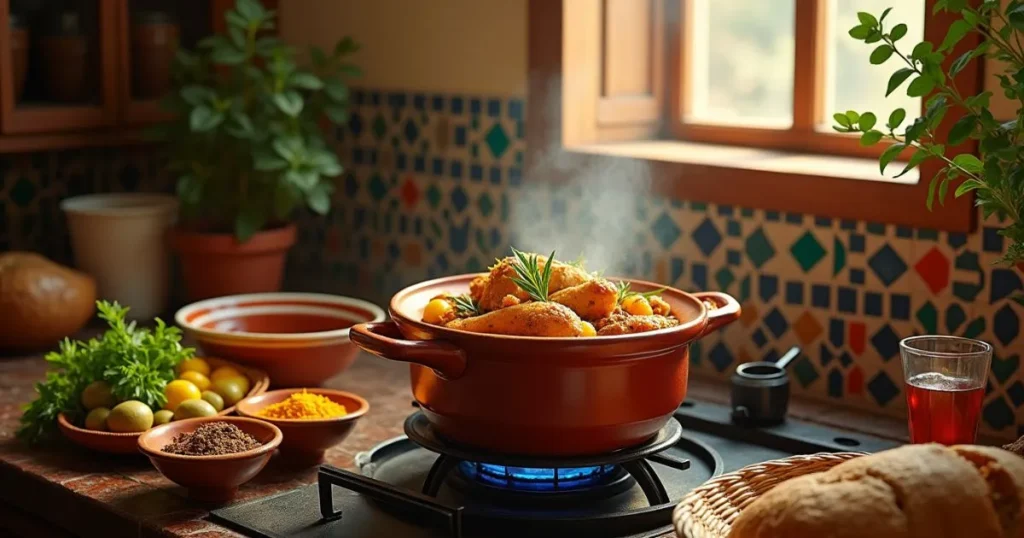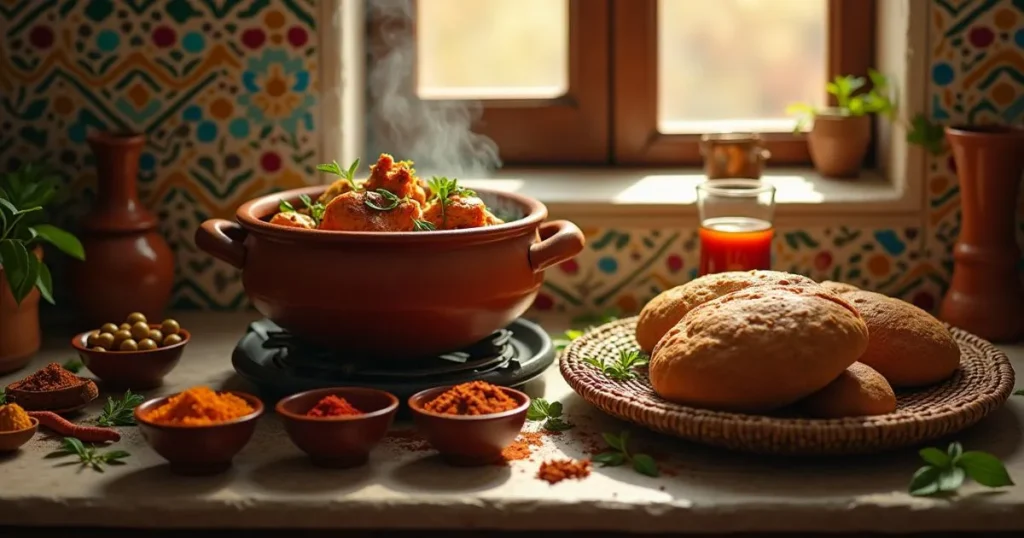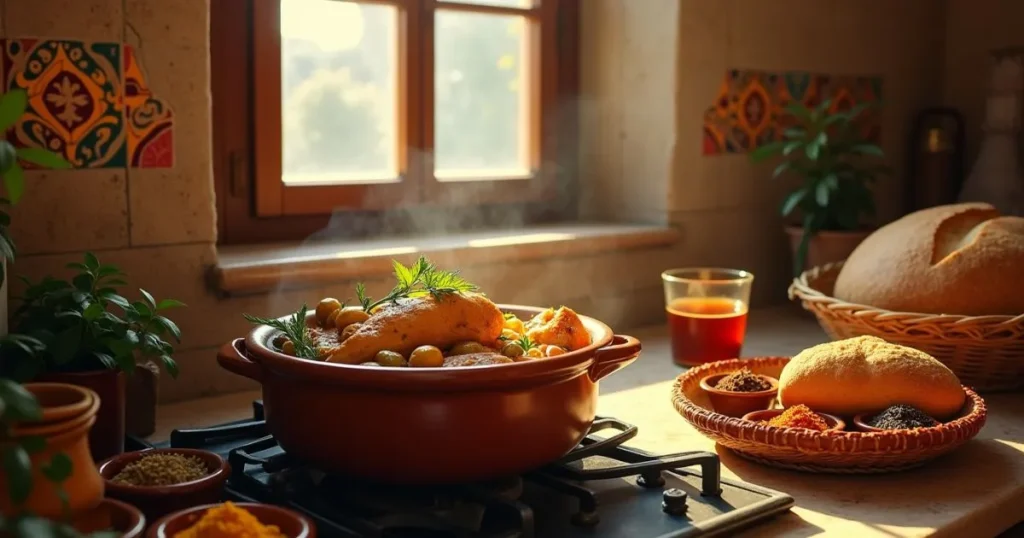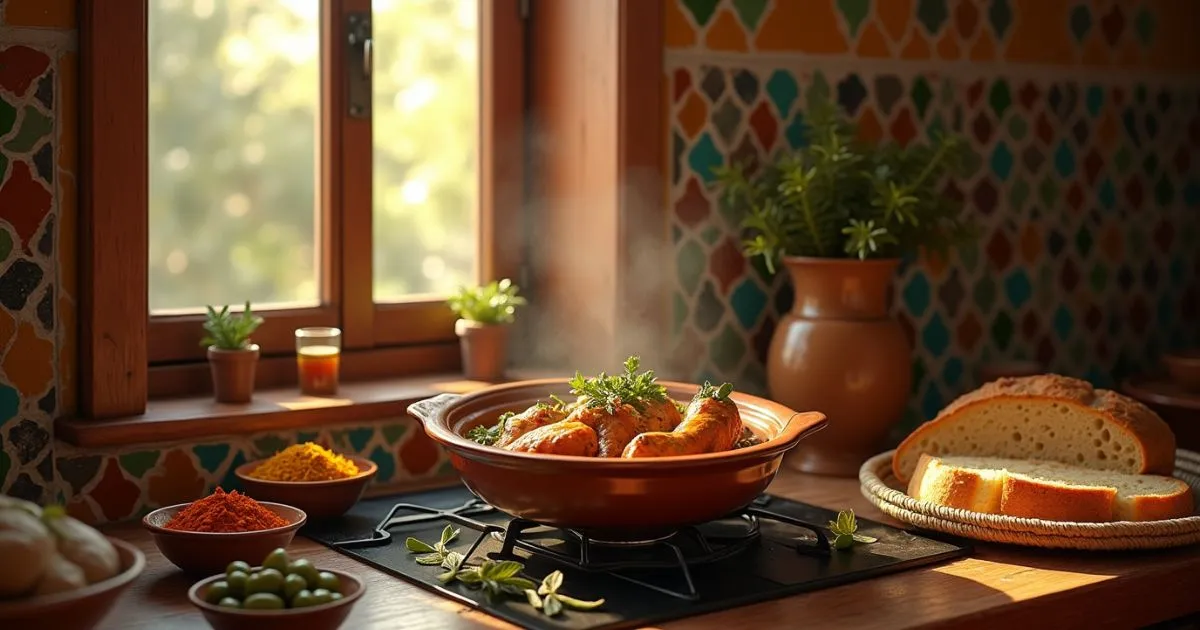Table of Contents
Discover how to make authentic Moroccan chicken tagine (Step-by-Step Guide)
A Journey Through Flavor and Memory
Imagine standing in a sunlit Moroccan kitchen, the air thick with the fragrance of turmeric, ginger, and garlic sizzling in olive oil. You hear the gentle simmer of a tagine pot and know something extraordinary is being created. This dish brings a sense of comfort and connection that feels like home. You’re not just preparing a meal; you’re stepping into a centuries-old tradition passed down through generations. If you’ve ever wanted to bring that magic into your own kitchen, you’re in the right place. This guide will show you how to create an authentic Moroccan chicken tagine from start to finish.
What Is Chicken Tagine? An Icon of Moroccan Cuisine
A Brief History of Tagine Cooking
Chicken tagine is more than just a dish; it’s a cultural symbol. Originating in North Africa, the tagine is both the name of the dish and the cone-shaped clay pot used to cook it. The method dates back to Berber communities, blending influences from Arab, Mediterranean, and even Andalusian traditions over centuries.
Why Chicken Tagine Is So Beloved
This dish is beloved for a reason:
- It balances sweet, savory, and tangy flavors.
- It’s deeply aromatic yet not overpowering.
- This recipe fits just as well into weeknight dinners as it does on special occasions.
- It’s cooked slowly, allowing flavors to deepen and textures to become irresistibly tender.

Ingredients You’ll Need to Make Chicken Tagine
Traditional Ingredients
| Ingredient | Quantity | Notes |
|---|---|---|
| Bone-in chicken | 1 whole (cut) | Thighs or legs work best |
| Onions | 2 large | Thinly sliced |
| Garlic | 4 cloves | Crushed or finely chopped |
| Preserved lemons | 1–2 pieces | Key to authentic flavor |
| Green/purple olives | 1 cup | Moroccan-style preferred |
| Saffron threads | A pinch | Adds depth and aroma |
| Ground turmeric | 1 teaspoon | For earthy warmth and golden hue |
| Ground ginger | 1 teaspoon | Provides sharp, warming flavor |
| Olive oil | 2–3 tablespoons | For sauteing and flavor foundation |
| Fresh cilantro | ½ bunch | Chopped, used as garnish |
| Water or broth | 1 cup | For moisture during slow cooking |
Your Guide to Cooking: Step-by-Step
Step 1 – Marinate the Chicken
Start by rubbing the chicken with a blend of garlic, ground turmeric, fresh ginger, a pinch of saffron, and a drizzle of olive oil. Let it rest for at least an hour, but if time allows, marinate overnight. Doing this helps each piece soak up deep, bold flavors.
Step 2 – Build the Flavor Base
Layer your sliced onions on the bottom of the tagine pot. Place the marinated chicken on top. Scatter preserved lemons and olives throughout. As the dish simmers, the lemons and olives gently infuse the chicken with rich, savory notes.
Step 3 – Slow and Gentle Cooking
Add a cup of water or broth. Cover with the lid. If using a traditional clay tagine, cook over low heat using a diffuser to prevent cracking. Let it cook slowly for about an hour and a half, maybe two—just keep an eye on the liquid level as it simmers.
Step 4 – Finish with Fresh Herbs
Just before it hits the table, toss on some fresh-cut cilantro for a final burst of flavor. Serve directly from the tagine with warm bread or a side of fluffy couscous.

Chicken Tagine Variations You Can Try
Chicken Tagine with Apricots and Almonds
- Adds natural sweetness and a nutty crunch
- A festive option often served during holidays
Spicy Chicken Tagine with Harissa
- Brings heat with a Moroccan chili paste
- Great for those who enjoy a bit of a kick
Vegetable-Packed Chicken Tagine
- Include carrots, zucchini, or potatoes
- A complete, hearty meal in one pot
Handy Advice for Nailing Your Chicken Tagine at Home
Equipment Tips
- Traditional tagines are ideal but not essential
- If you don’t have a tagine, a sturdy pot with a good lid—like a Dutch oven—will do just fine.
Spice Substitutions
- No saffron? Use extra turmeric and a bit of paprika
- Can’t find preserved lemons? Combine lemon juice and finely grated zest for a quick alternative to preserved lemons.
Mistakes to Avoid
- Letting the chicken absorb the spices deeply is essential for bringing out its richest flavors.
- Don’t overheat the tagine; use low, consistent heat
- Avoid too much liquid, which can make the sauce watery
What to Serve with Moroccan Chicken Tagine
- Khobz (Moroccan flatbread): Perfect for scooping up sauce
- Couscous: Especially good with added raisins or nuts
- Fresh salad: Tomato, cucumber, and red onion with lemon dressing
- Mint tea: Traditional and refreshing as a post-meal drink
Why Make it at Home?
- Brings a piece of Morocco to your table
- Uses natural, wholesome ingredients
- Impressive for guests and comforting for family
- It gives you the chance to play with spices you might not usually cook with.

Frequently Asked Questions (FAQ) About Chicken Tagine
Is a traditional tagine pot necessary to make this dish at home?
Not at all. While it enhances authenticity, you can make a delicious version in a Dutch oven or heavy saucepan with a lid.
How long does it take to cook chicken tagine?
Plan for about 1.5 to 2 hours of slow simmering to achieve tender, flavorful chicken.
Can I freeze leftovers?
Yes, chicken tagine freezes well. Keep leftovers in a sealed container and warm them gently to maintain taste and texture.
What makes preserved lemons special?
They’re fermented with salt, giving them a tangy, almost floral quality that fresh lemons can’t replicate.
Is chicken tagine spicy?
Traditionally, it’s more aromatic than hot. Add a bit of chili paste or harissa if you like your meals with a fiery edge.
Conclusion – Bring the Heart of Morocco to Your Kitchen
Now that you know how to prepare an authentic Moroccan chicken tagine, it’s your turn to try it. From the marinated chicken to the preserved lemons and fragrant spices, every element of this dish tells a story. It’s about more than food—it’s about history, culture, and creating memories around your table.
Call to Action
Want to experience the heart of Moroccan cooking right in your own kitchen? This is your moment. Save this recipe, share it with someone who loves global flavors, and don’t forget to tag your homemade tagine creations on social media. Let your culinary journey begin today!

